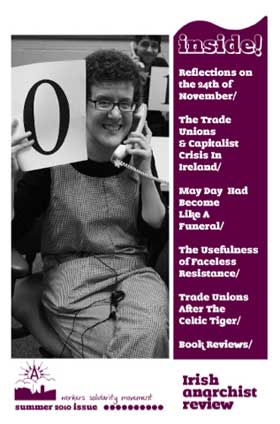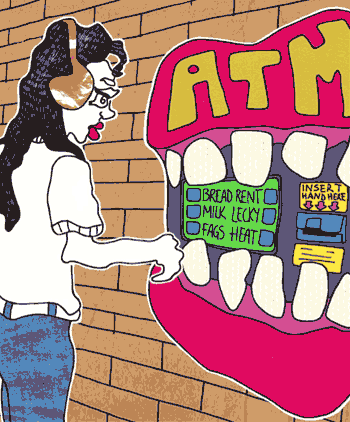Over 30 years of anarchist writing from Ireland listed under hundreds of topics
Irish Anarchist Review Issue 1
 Welcome to the first issue of The Irish Anarchist Review, the new political magazine from the Workers Solidarity Movement. This magazine will explore ideas and practical struggles that can teach us about building a revolutionary movement today. We decided to cease printing Red & Black Revolution, and start this project, aimed at provoking debate and discussion among anarchists and the left. For this purpose, we will be pursuing a non-sectarian approach, taking ideas from various left currents, mainstream discourse, and reflections on experiences of life and struggle. We will take, print, and discuss, anything that we find useful for our needs. We hope that readers will have a similar attitude, and will use the magazine to discuss, debate and develop ideas. We will also welcome submissions and responses to articles.
Welcome to the first issue of The Irish Anarchist Review, the new political magazine from the Workers Solidarity Movement. This magazine will explore ideas and practical struggles that can teach us about building a revolutionary movement today. We decided to cease printing Red & Black Revolution, and start this project, aimed at provoking debate and discussion among anarchists and the left. For this purpose, we will be pursuing a non-sectarian approach, taking ideas from various left currents, mainstream discourse, and reflections on experiences of life and struggle. We will take, print, and discuss, anything that we find useful for our needs. We hope that readers will have a similar attitude, and will use the magazine to discuss, debate and develop ideas. We will also welcome submissions and responses to articles.
This issue is shaped by the current financial crisis, and more particularly, by the reactions of the Irish political and capitalist classes, as they pursue an aggressive strategy of cutbacks. We have seen the implosion of the building sector, the foundering of the banks upon corruption and incompetence and the failure of our foreign investment based economic model. Moreover, we have seen that the government response has been to protect the banks and builders by transferring wealth from social services, public pay and increased taxation straight into bank bailouts and NAMAland. This needs to be identified for what it is: an act of outright class warfare.
We are faced with a situation where a strong and organised response to government attacks is absolutely necessary, but is constrained by the prevailing ideology and practice of partnership. The most pressing concern for Irish radicals today is to build a labour movement that rejects the corporatist mentality and service-delivery model of ICTU and poses instead workers self-organisation as the basis for struggle. With this in mind, this and future issues will look for inspiration in revitalising class-based politics.
 The weakening of Irish organised labour through the ‘Celtic Tiger’ period is examined by James R’s article, and he poses some requirements for the emergence of a class movement that can deal with the threats of the present while bearing a vision of a better future. Andrew Flood looks at some of the positive elements of recent struggles, emphasising the possibilities for self-organisation and direct action made visible in the recent struggles.
The weakening of Irish organised labour through the ‘Celtic Tiger’ period is examined by James R’s article, and he poses some requirements for the emergence of a class movement that can deal with the threats of the present while bearing a vision of a better future. Andrew Flood looks at some of the positive elements of recent struggles, emphasising the possibilities for self-organisation and direct action made visible in the recent struggles.
We feature two articles that try to learn from the experiences of radicals internationally. Ronan McAoidh reviews the work of Swedish group, Kämpa Tillsammans!, which argues that affinity between workers, not just union organisation, is the basis of successful struggles. An interview with Alex Foti explores organising tactics that try to deal with the growing trend of flexible working conditions.
The reviews also tie into this theme, assessing the development of an American working-class counter-culture and, by looking at workplace blogging, discussing some ways in which this can be done today.
Overall, this issue attempts to learn from the current weakness of the Irish working class, and explores both the origins of this weakness and some routes towards a combative class movement, capable of disrupting the ruling class offensive on living and working conditions and posing an altogether different vision of society, and, most importantly, a way of getting there.
WORDS : DARA MCAOIDH
Articles
Reflections on the 24th November
On the 24th of November something extraordinary happened. Some 250,000 workers acted together in a day-long strike against the public sector wage cuts planned by the government. The vast majority of these workers had never gone on strike before, yet across almost all workplaces the strike involved 90% or more of those working.
Capitalist crisis and union resistance in Ireland
Late 2008 saw the Irish capitalist class wage a major ideological struggle against the Irish working class. They called for workers to bear the brunt of the capitalist crisis. Print media, TV and radio carried segment after segment where well-paid commentators argued that workers, in particular public sector workers, were earning too much, had overly generous pensions and that the public had unrealistic expectations of public services.
The usefulness of Faceless Resistance
Although Faceless Resistance as a concept has been discussed among radical circles in Sweden for several years, it has only recently begun to be noticed in the English speaking world, primarily due to delays in texts being translated. In this article I will look primarily at the work of Kämpa Tillsammans, who developed the core ideas of Faceless Resistance, but I will also situate these ideas in their historical and social context and introduce other tendencies that have been influenced by and adapted some of the theory.
Mayday had become like a funeral - interview with Alex Foti
In the middle years of this decade, Alex Foti became known across activist circles for involvement in the Euromayday Parades. In a special themed issue of Green Pepper, Foti and the Chain Workers Collective sketched a very attractive understanding of the work discipline of contemporary capitalism. In their understanding, society had found itself in a situation of profound disjuncture with our working pasts - life today was defined by contingent employment rather than the traditional job for life.
The unions after the celtic tiger
A rather strange figure is moving to centre stage in Irish politics, that of the trade unions - absent from mass struggles until recently and weakened over the decades of social partnership, they are now the only possible source of a movement that can confront attemps to transfer the cost of the recession to working people. This statement does not come with out some qualms.
Checkout: Life On The Tills
“Anna Sam”, as you might guess, is a pseud- onym, the handle of a French blogger who decided to put her years behind the till to good use on a website describing the day-to- day experience of supermarket workers in all its tedious glory. In a way it’s refreshing to discover that the psychology of the checkout girl / boy appears to be the same wherever you go - my own days at Centra and the like are well imprinted on the brain, but they could have been an atypical reflection of my general misanthropy, grumpiness and ill will towards the rest of the species.
Review: The IWW and The Making of a Revolutionary Working Class Counter culture
The book can be read in a number of ways; on one hand it rescues the IWW from Stalinist critics that fashionably flounced after Russian Bolshevism; it gives insight to the politics and personalities of the union itself and rescues Hill the man. But as suggested by the subtitle, it’s Rosemont’s treatment of how the IWW built a counter hegemonic working class culture that is the most interesting facet of this brick thick work.
Extras
We couldn't fit all the articles written for IAR1 into the ptinted version. Here are additional articles that were just published online
Shifu and the possibilities for Chinese Anarchism
 In July 1914, the Shanghai Association of Anarchist Communist Comrades published its statement of principles, concluding with the resolution that, "the implementation of anarchist communism depends on the strength of our party. If we wish to increase our party's strength, uniting as a whole body and advancing together is our most important task today. Wherever they are, all our comrades should unite with those who share the same purposes and establish groups in free association.” The key member of this group was a Chinese anarchist known as Shifu who was to die a mere nine months later. Although the group carried on after his death, the core concept of this paragraph was never to be implemented.
In July 1914, the Shanghai Association of Anarchist Communist Comrades published its statement of principles, concluding with the resolution that, "the implementation of anarchist communism depends on the strength of our party. If we wish to increase our party's strength, uniting as a whole body and advancing together is our most important task today. Wherever they are, all our comrades should unite with those who share the same purposes and establish groups in free association.” The key member of this group was a Chinese anarchist known as Shifu who was to die a mere nine months later. Although the group carried on after his death, the core concept of this paragraph was never to be implemented.

All photos used in this publication were sourced under a Creative Commons License on Flickr.com.
The following usernames are credited. Page 3, 4 and 16: Infomatique. Page 6, 12 : Antrophe. Page 7: Asid- script. Page 8 and 10 Cinocino. Page 15: pasukaru Page 14: Mlibrarianus and Laburbuja. Page 15: alam- osbasement Page 18: Artecallejoro. Page 20: Cashen. Page 21: Erikwdavis. Page 23: Bear Clause.
Frontpage illustration: helene pertl Backpage illustration: lisa crowne
Irish Anarchist Review Facebook fan page
Launch of Irish Anarchist Review - audio recording of launch at Dublin anarchist bookfair
| Attachment | Size |
|---|---|
| PDF of Issue 1 of Irish Anarchist Review | 6.61 MB |

